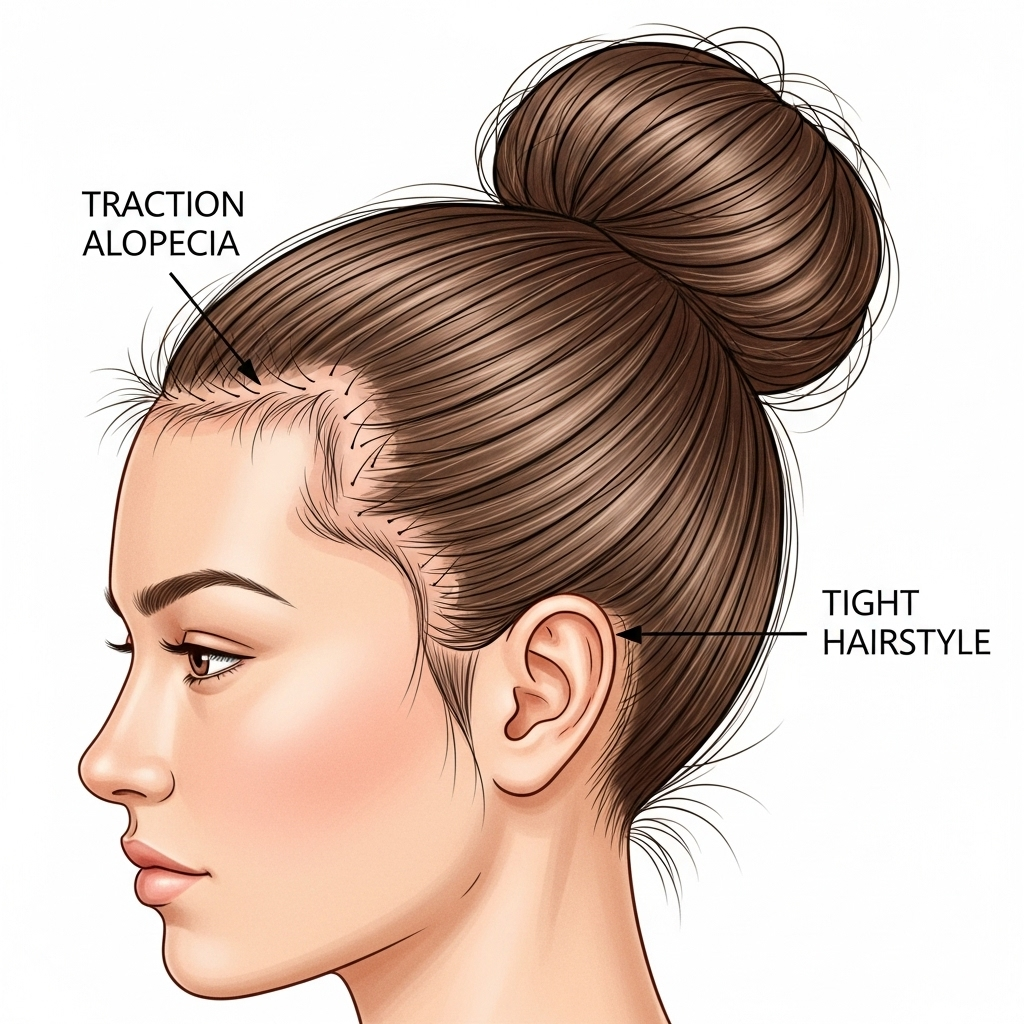Hair is often described as a person’s crowning glory. It’s an essential part of self-expression and identity, reflecting personality and style. But did you know that the way you wear your hair could be causing it to fall out? Many hairstyles, especially when worn tightly or frequently, can contribute to hair loss, sometimes leading to permanent damage if not addressed early. At ZMD Hair, we understand how important it is to protect your hair while looking your best. In this article, we’ll explore how hairstyles can contribute to hair loss, what exactly happens to your hair follicles, and what styles and habits you should avoid to maintain healthy, strong hair.
Understanding Hairstyle-Related Hair Loss
The hair loss caused by certain hairstyling practices is medically known as traction alopecia. This condition occurs when hair follicles experience chronic tension or pulling, which weakens them over time. Unlike genetic hair loss, traction alopecia is often preventable if caught early and managed properly.
How Does Traction Alopecia Develop?
Hair follicles are tiny, delicate organs anchored beneath the scalp that produce hair strands. When you consistently pull or strain hair follicles through tight hairstyles, it creates stress that the follicles cannot withstand indefinitely. Over time, this stress causes inflammation, follicle damage, and eventually results in hair thinning and hair loss.
Areas most commonly affected are along the hairline, temples, and behind the ears—places where tension is usually greatest. If the pulling continues unchecked, the follicles may be permanently damaged, leading to irreversible hair loss.
Factors That Increase the Risk
- Frequency and Duration: Wearing tight hairstyles daily or for extended periods increases risk.
- Tension Intensity: Styles that pull hair excessively, such as very tight braids or ponytails, cause more damage.
- Hair Texture and Condition: Fragile, brittle hair is more susceptible to breakage under tension.
- Chemical Treatments: Relaxers, dyes, or heat styling weaken hair and follicles, compounding the problem.
Common Hairstyles That Can Cause Hair Loss
Certain popular hairstyles, while fashionable, can put your hair health at risk, especially when worn tightly or continuously without breaks.
Tight Ponytails and Buns
Ponytails and buns pulled tight are among the most common culprits. The constant tension on the scalp causes stress along the hairline and temples, leading to noticeable thinning and recession in these areas. Wearing them daily or during sleep magnifies the damage.
Braids and Cornrows
Braided styles and cornrows often require hair to be pulled very tight, especially when freshly done. Additionally, the scalp may experience pressure and friction, weakening follicles. The heavier the braid or the tighter the weave, the higher the risk.
Dreadlocks and Extensions
While dreadlocks are a unique and beautiful style, improper maintenance or extremely tight locking can lead to pulling at the roots. Hair extensions, especially those sewn or glued tightly to the scalp, add weight and tension that can cause hair breakage and follicle damage.
Heat Styling with Tension
Using curling irons, flat irons, or blow dryers combined with tight hairstyles dries out hair shafts, making them brittle. When brittle hair is pulled or styled tightly, it snaps easily, contributing to hair loss.
How to Recognize If Your Hairstyle is Causing Hair Loss
Not everyone realizes that their styling routine is harming their hair until the damage is advanced. Recognizing early warning signs can save your hair.
Warning Signs to Watch For
- Thinning at the Hairline or Temples: Receding edges or patchy hair loss in these areas are classic signs.
- Increased Hair Shedding After Hairstyling: Finding more hair in brushes or on pillows, especially after removing tight styles.
- Scalp Discomfort: Tingling, tenderness, or soreness around areas where hair is pulled tight.
- Broken or Split Hair Strands: Short, brittle hairs near the roots that break easily.
- Bald Patches: Areas of noticeable thinning or complete bald spots.
If you notice any of these symptoms, it’s important to adjust your hairstyle habits and seek professional advice before the damage worsens.
What Hairstyles and Habits Should You Avoid?
Preventing traction alopecia is about balancing style with hair health. Here are hairstyles and habits to be cautious about:
Avoid Wearing Tight Hairstyles Every Day
Consistently pulling hair back into tight ponytails or buns doesn’t allow follicles to rest. Limit these styles to occasional wear, and alternate with looser, more natural looks.
Be Cautious with Braids and Weaves
If you love braids or weaves, ensure they’re not too tight and avoid keeping them for long durations. Give your scalp breaks between styles to recover.
Limit Heavy Extensions
Heavy or poorly applied extensions can place excess weight on your natural hair, causing breakage and follicle damage. Choose lightweight extensions and avoid tight attachment methods.
Reduce Heat Styling and Chemical Treatments
Excessive heat or harsh chemicals weaken hair structure, making it more prone to breakage under tension. Use heat protectants, limit frequency, and opt for gentle, nourishing hair products.
Avoid Sleeping with Hair Pulled Tight
Sleeping with tight hairstyles increases tension overnight, a time when your scalp needs to relax. Loosen hair or switch to protective, loose styles before bed.
Healthy Hair Styling Tips for Prevention
Protecting your hair doesn’t mean sacrificing style. These tips allow you to look great while maintaining hair health:
- Choose Loose, Low-Tension Styles: Soft waves, loose braids, or low ponytails reduce follicle stress.
- Use Gentle Hair Accessories: Avoid rubber bands and opt for scrunchies or fabric-covered elastics that minimize pulling.
- Regular Scalp Massage: Improves blood flow and relieves tension, promoting hair health.
- Moisturize and Condition: Well-hydrated hair is stronger and less prone to breakage.
- Give Your Hair Breaks: Rotate hairstyles and avoid wearing any tight styles continuously.
When to Seek Professional Help
If hair loss or scalp discomfort persists, it’s essential to consult a hair specialist. Early treatment of traction alopecia can restore hair growth and prevent permanent damage. At ZMD Hair, our experts assess your hair health comprehensively and design personalized treatment plans combining medical therapies, scalp care, and lifestyle adjustments.
Conclusion: Protect Your Hair by Styling Smart
Hairstyles are a powerful form of self-expression but can inadvertently cause hair loss if they put constant strain on your hair follicles. Traction alopecia is preventable, and by understanding which styles and habits contribute to hair loss, you can enjoy your favorite looks without compromising hair health.
If you’re noticing signs of hair thinning or shedding linked to your hairstyles, don’t wait. Contact ZMD Hair today for a thorough consultation. Our expert team will help you identify risk factors, suggest healthier styling alternatives, and recommend effective treatments to restore and protect your hair.
Your hair deserves care, not damage. Take the first step toward lasting hair health by scheduling your appointment with ZMD Hair now. Style smart, protect your follicles, and enjoy the confidence that comes with a full, healthy head of hair.




